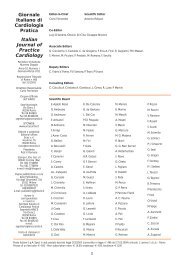Scarica il documento in formato pdf (556 KB) - ANCE
Scarica il documento in formato pdf (556 KB) - ANCE
Scarica il documento in formato pdf (556 KB) - ANCE
You also want an ePaper? Increase the reach of your titles
YUMPU automatically turns print PDFs into web optimized ePapers that Google loves.
30<br />
Venous Thromboembolism: natural history<br />
and implications for management<br />
La Malattia Venosa Tromboembolica:<br />
storia naturale e implicazioni terapeutiche<br />
S. Coccheri<br />
La Malattia Venosa Tromboembolica (MVT) è una malattia cronica ricorrente. La sua <strong>in</strong>cidenza nella popolazione è di 1-2<br />
casi per 1000 soggetti/anno. La mortalità dei pazienti con MVT è sorprendentemente alta e, solo <strong>in</strong> parte (20%), spiegata<br />
dall'Embolia Polmonare (EP). Negli altri casi l'esito fatale è relativo alle condizioni di fondo: <strong>in</strong>fatti, i fattori di rischio per la mortalità<br />
precoce sono l'età, la chirurgia, <strong>il</strong> sesso masch<strong>il</strong>e, la "frag<strong>il</strong>ità fisica", la lunga degenza a letto, le malattie cardiopolmonari, i tumori.<br />
I più importanti fattori di rischio per la MVT sono la chirurgia, le malattie mediche, le neoplasie maligne, la gravidanza, i<br />
contraccettivi orali, un alto <strong>in</strong>dice di massa corporea, e le trombof<strong>il</strong>ie primarie. L'effetto trombogenico dei contraccettivi orali<br />
è grandemente potenziato dalla presenza di una delle due più comuni mutazioni trombof<strong>il</strong>iche (dei fattori V e II). Le recidive<br />
di Trombosi Venosa Profonda (TVP) con o senza EP raggiungono <strong>il</strong> 16% entro i primi 2 anni e circa <strong>il</strong> 30% <strong>in</strong> 10 anni.<br />
Tuttavia <strong>il</strong> rischio assoluto di ricorrenza cala fortemente nel tempo. I più importanti fattori favorenti la recidiva sono: la natura<br />
idiopatica anziché secondaria del 1° episodio, la presenza di fattori di rischio permanenti anziché transitori, la sede della trombosi,<br />
prossimale anziché distale, mentre <strong>il</strong> ruolo delle mutazioni del V e del II è ancora dibattuto. Tra i pazienti che si presentano<br />
con EP come primo episodio, <strong>il</strong> tasso di mortalità nelle ricorrenze è particolarmente elevato. Attualmente, si stanno sv<strong>il</strong>uppando<br />
approcci rivolti alla previsione delle recidive. Il nostro gruppo ha dimostrato <strong>il</strong> valore predittivo negativo del D-Dimero (D-D)<br />
misurato dopo la sospensione della terapia anticoagulante orale (TAO). Accoppiando la determ<strong>in</strong>azione del D-D con la<br />
valutazione ecografica del residuo trombotico venoso (RVT) si ottiene un potere predittivo delle recidive assai elevato. Nel<br />
futuro questi e altri criteri diventeranno ut<strong>il</strong>i per "confezionare una TAO su misura" per <strong>il</strong> s<strong>in</strong>golo paziente. Solo <strong>in</strong> pazienti a<br />
rischio molto alto di recidive la TAO deve essere cont<strong>in</strong>uata per più di 1 anno, e solo raramente per tutta la vita. I nuovi<br />
<strong>in</strong>ibitori orali della tromb<strong>in</strong>a sono molto promettenti, e altrettanto efficaci, ma non più sicuri, dei cumar<strong>in</strong>ici: pertanto, gli stessi<br />
pr<strong>in</strong>cipi saranno verosim<strong>il</strong>mente confermati anche per questi nuovi farmaci.<br />
Deep Venous Thrombosis (DVT) is a chronic recurrent disease. The <strong>in</strong>cidence of DVT <strong>in</strong> the general population ranges between<br />
1 and 2 cases per 1000 persons per year. The all cause mortality of this condition is surpris<strong>in</strong>gly high with<strong>in</strong> the first 30 days from the<br />
acute episode. Fatal pulmonary embolism (PE) is responsible for mortality <strong>in</strong> 20% of the lethal cases. Factors for early death are age,<br />
male gender, physical fra<strong>il</strong>ty, conf<strong>in</strong>ement to bed, heart-lung disease, and malignancy. Risk factors for venous thromboembolism<br />
(VTE) are surgery, medical <strong>il</strong>lnesses, malignancy, pregnancy, hormonal contraceptives, an <strong>in</strong>creased body mass <strong>in</strong>dex, and the<br />
primary thromboph<strong>il</strong>ias. The thrombogenic effect of oral contraceptives is greatly potentiated by the presence of one of the two<br />
commonest thromboph<strong>il</strong>ic mutations (of Factors V and II). Recurrences cumulatively amount to about 16% with<strong>in</strong> the first 2 years<br />
and may reach even 30% <strong>in</strong> ten years. However the absolute hazard of recurrence per 1000 patients/days sharply decl<strong>in</strong>es over<br />
time. Ma<strong>in</strong> factors for recurrences are idiopathic versus provoked DVT, permanent versus transient risk factors, proximal versus<br />
distal DVT, wh<strong>il</strong>e the role of Factor V and II mutations is st<strong>il</strong>l matter of debate. Among patients present<strong>in</strong>g with PE, the case-fatality<br />
rate of recurrent VTE is high. Attempts at prediction of recurrences are presently develop<strong>in</strong>g. The negative predictive power of<br />
D-Dimer measured after stopp<strong>in</strong>g anticoagulation has been extensively studied by our group. Coupl<strong>in</strong>g of D-Dimer with<br />
ultrasonographic evaluation of residual ve<strong>in</strong> thrombosis (RVT) greatly enhances the predictive power of D-Dimer and RVT taken<br />
alone.In the future, these and other criteria might become useful <strong>in</strong> order to "ta<strong>il</strong>or" anticoagulant therapy on the <strong>in</strong>dividual patient.<br />
Only patients at very high risk of recurrences should be treated with oral anticoagulants for more than 12 months and only<br />
sometimes for their whole life. The new oral thromb<strong>in</strong> <strong>in</strong>hibitors are very promis<strong>in</strong>g, and as effective but no safer than coumar<strong>in</strong>s:<br />
thus, the same pr<strong>in</strong>ciples are likely to be confirmed also for these new drugs.<br />
(It J Practice Cardiol 2003;1:30-35)<br />
Key words: deep ve<strong>in</strong> thrombosis • pulmonary embolism • venous thromboembolism recurrences<br />
oral anticoagulants • new antithromb<strong>in</strong> agents<br />
© 2003 <strong>ANCE</strong> Ricevuto <strong>il</strong> 18 ottobre 2003; accettato <strong>il</strong> 21 novembre 2003.<br />
Vascular Medic<strong>in</strong>e, University of Bologna, Italy.<br />
Cl<strong>in</strong>ical Research Unit on Thromboph<strong>il</strong>ias, "Mar<strong>in</strong>o Gol<strong>in</strong>elli" Foundation
















